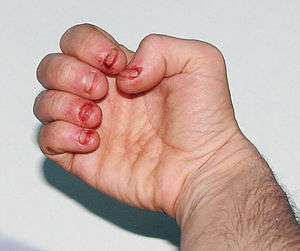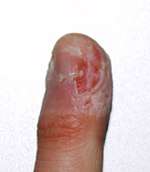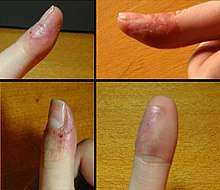Dermatophagia
Dermatophagia (from Ancient Greek δέρμα - skin - and φαγεία - eating) is a compulsion disorder of gnawing or biting one's own skin, most commonly at the fingers. This action can either be conscious or unconscious.[1] Those affected with dermatophagia typically bite the skin around the nails, leading to bleeding and discoloration over time. Some people also bite on their skin on their finger knuckles which can lead to pain and bleeding just by moving their fingers. It has been proposed that dermatodaxia would be a more fitting term for this disorder, as the suffix '-phagia' implies that the skin is being eaten rather than simply bitten. In most cases of dermatophagia in humans, the skin is only bitten with no consumption.[2] In herpetology, dermatophagia is used to correctly describe the act in which amphibians and reptiles eat the skin they shed,[3] but this is not what occurs in humans. Those diagnosed with this disorder do not develop wounds on the bitten areas of their hands or lose any skin. Instead, they experience a thickening of the skin being repeatedly bitten. This information implies that the skin is simply being bitten and chewed rather than eaten.[4] Contemporary research suggests a link between impulse control disorders and obsessive–compulsive disorders,[5] and this was addressed in the DSM-5 when dermatophagia and other related disorders were classified as 'other specified obsessive-compulsive related disorders' and are given the specification of body focused repetitive behavior.[6] Further information on OCD, other anxiety disorders, dermatophagia and other related body focused repetitive behaviors can be found in the DSM-5[7]
| Dermatophagia | |
|---|---|
 | |
| Extreme nail biting / biting of skin to point of an obsessive compulsive disorder (OCD) or other condition leading to self mutilating behavior such as autistic spectrum disorders (as is the case in this example) or Lesch-Nyhan Syndrome | |
| Specialty | Psychiatry |
| Types | Ocd |


Behavior
People with dermatophagia chew their skin out of compulsion, and can do so on a variety of places on their body.[8] Those with dermatophagia typically chew the skin surrounding their fingernails and joints. They also chew on the inside of their mouth, cheeks, and/or lips, causing blisters in and outside of the mouth. If the behavior is left unchecked for an extended period, calluses may start to develop where most of the biting is done.
Skin chewing can be bolstered by times of apprehension and other unpleasant events.[8] Blisters in particular can cause a feeling of desire to pull or bite off the affected skin and nails (since the skin is dead, thus easily pulled off), which could be detrimental, causing infection. Another disorder, known as excoriation disorder, the repetitive action of uncontrollably picking at one's skin, can sometimes accompany dermatophagia. Dermatophagia differs from excoriation disorder in that the repetitive motion affected persons partake in is the biting of the skin.[2] People who have dermatophagia can also be prone to infection as when they bite their fingers so frequently, they make themselves vulnerable to bacteria seeping in and causing infection. Dermatophagia can be considered a "sister" disorder to trichophagia, which involves compulsively biting and eating one's hair.[9]
Management
There is not yet a known way to remedy this in adults. Small things can be done to delay the urge a bit, such as chewing gum, and chewing on a soft drink straw.
Management in children with disabilities
There is no therapy known to effectively treat dermatophagia, however there have been attempts at stopping sufferers from being able to chew on their skin. One notable method that is currently in development is focused on in curbing dermatophagia in children with cerebral palsy. This method is known as the PLAY (Protecting Little and Adolescent hands) hands protective glove. This method of intervention involves small, non-invasive plastic brackets being placed around the affected fingers. These brackets do not hinder movement or tactile feedback, and they are constructed from non-toxic durable plastic that can withstand the force of chewing.[10] Presently PLAY hands protective gloves exist in concept and prototype only, but this intervention method could improve the quality of life of those suffering from CP-induced dermatophagia.
In popular culture
In the movie Austin Powers in Goldmember, the titular villain eats flakes of his own skin that have already peeled off on their own (desquamation).
Notes
- Scott, MJ; Scott, MJ (January 1997). "Dermatophagia: "wolf-biter"". Cutis. 59 (1): 19–20. ISSN 0011-4162. PMID 9013066 – via Europe PMC.
- Hawsawi, Khalid Al; Pope, Elena (August 2011). "Pediatric Psychocutaneous Disorders". American Journal of Clinical Dermatology. 12 (4): 247–257. doi:10.2165/11589040-000000000-00000. ISSN 1175-0561. PMID 21548659.
- Weldon, Paul (June 1993). "A Survey of Shed Skin-Eating in Amphibians and Reptiles". Journal of Herpetology. 27: 219–228 – via JSTOR.
- Mitropoulos, Panagiotis; Norton, Scott (August 2005). "Dermatophagia or dermatodaxia?". Journal of the American Academy of Dermatology. 53 (2): 365. doi:10.1016/j.jaad.2005.04.021. PMID 16021151 – via JAAD.
- Grant; et al. (January 2010). "Impulse-control disorders in children and adolescents with obsessive-compulsive disorder". Psychiatry Res. 175 (1–2): 109–13. doi:10.1016/j.psychres.2009.04.006. PMC 2815218. PMID 20004481.
- American Psychiatric Association (2016). Supplement to Diagnostic and Statistical Manual of Mental Disorders, Fifth Edition. pp. 12–14.
- American Psychiatric Association (2013). Diagnostic and Statistical Manual of Mental Disorders.
- Al Hawsawi, K.; Al Aboud, K.; Ramesh, V. (2003). "Dermatophagia Simulating Callosities". Dermatology Psychosomatics. 4: 42–43. doi:10.1159/000070535.
- "Dermatophagia". fingerfreak. FingerFreak.com. Retrieved April 27, 2009.
- Houston-Hicks, Michele; Lura, Derek J.; Highsmith, M. Jason (September 18, 2016). "PLAY HANDS PROTECTIVE GLOVES: TECHNICAL NOTE ON DESIGN AND CONCEPT". Technology & Innovation. 18 (2–3): 207–210. doi:10.21300/18.2-3.2016.207. ISSN 1949-8241. PMC 5218531. PMID 28066530.